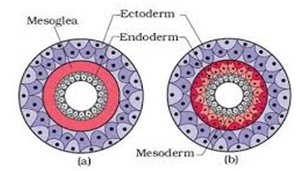11th And 12th > Biology
ANIMAL KINGDOM MCQs
:
A
A germ layer is a group of cells in an embryo, that interact with each other as the embryo develops and contribute to the formation of all organs and tissues. All animals, except sponges (sponges exhibit cellular level of organisation), form two or three germ layers. The germ layers develop early in embryonic life. Thus, based on the number of embryonic germ layers, organisms are categorised as diploblastic and triploblastic. Diploblastic organisms are those in which the embryonic stage includes just two layers - the ectoderm and the endoderm, from which the fully functional organism develops. A gelatinous substance called mesoglea fills the space between them. Triploblastic organisms are those which possess three germinal layers during embryonic development - the ectoderm, mesoderm and the endoderm, each of which gives rise to the various parts of the fully developed organism.
:
C
Acorn worm (Balanoglossus), belonging to the Phylum Hemichordata, is said to be the connecting link between the non-chordates and chordates. This is because it possesses certain characters found in chordates, in addition to many of its invertebrate features. The larval form of hemichordates is called tornaria, which resembles the bipinnaria larva of echinoderms.
:
C and D
Organ system level of organisation is observed in Phylum Aschelminthes (Nematoda), and all the groups above it in the Animal Kingdom. Sponges exhibit cellular level or organisation, while cnidarians exhibit tissue level of organisation.
:
D
The primary chordate characteristics include notochord, dorsal hollow nerve cord, paired pharyngeal gill slits and post-anal tail. The presence of hair is a characteristic feature of mammals.
:
C
The body of sponges is supported by spicules or spongin fibres. Ctenophores (comb jellies) exhibit bioluminescence, which is a property by which the organisms can emit light. Annelids possess structures called nephridia which help in excretion. Members belonging to Phylum Mollusca do possess a hard exoskeleton, but it is made up of calcium carbonate and not chitin. Chitinous exoskeleton is characteristic of arthropods.
:
C
The images are those of the following cartilaginous fishes:
1. Scoliodon has an elongated, spindle-shaped, body tapered at the ends. The trunk and tail are laterally compressed, while the head region is dorsoventrally compressed. It is commonly known as dogfish, and is a type of shark.
2. Pristis is commonly known as sawfish. It is characterised by a long, narrow, flattened rostrum, or nose extension, lined with sharp transverse teeth, arranged so as to resemble a saw, and hence, the name.
3. Carcharodon, known as the great white shark, is known to prey upon a variety of other marine animals, including fish and seabirds. It is also ranked among the top predators in having the most recorded shark bite incidents on humans.
4. Trygon, commonly known as stingray, has a diamond-shaped pectoral fin disc slightly wider than long, and a whip-like tail with upper and lower fin folds. A stinging spine is present on the tail, equipped with a venom gland at its base.
:
D
In amphibians, the alimentary canal, urinary and reproductive tracts open into a common chamber called cloaca which opens to the exterior.
:
C
The water vascular system is a hydraulic system typically used by echinoderms, such as sea stars and sea urchins, for locomotion, food and waste transportation, and respiration. Sea anemone and sea pen are cnidarians, while sea horse is a fish.
:
D
Invertebrates or non-chordates do not possess a notochord. Their nerve cord too, is double ventral, and not dorsal hollow like that of the chordates. Vertebrata is a sub-phylum under Phylum Chordata in which, the embryoic notochord gets replaced by a bony or cartilaginous vertebral column in the adult. All vertebrates are thus, chordates, but all chordates are not vertebrates.
:
C
Metamerism or segmentation is the phenomenon of having a linear series of body segments fundamentally similar in structure. The individual segments are known as metameres. However, not all these segments are entirely alike in any single life form because some of them perform special functions. Metameric segmentation can be distinctly seen in Annelida (e.g., earthworm) and Arthropoda (e.g., cockroach, prawn etc.). Most chordates too, exhibit segmentation at some point during their life history.

















